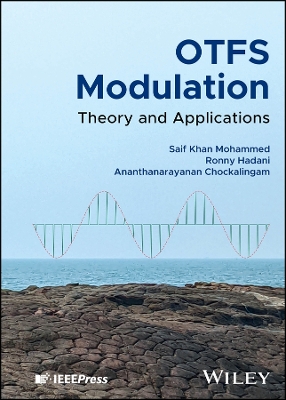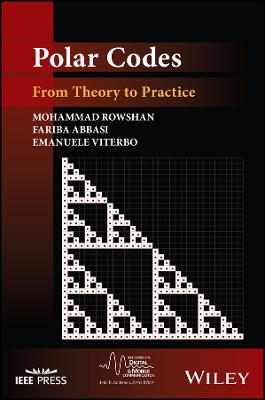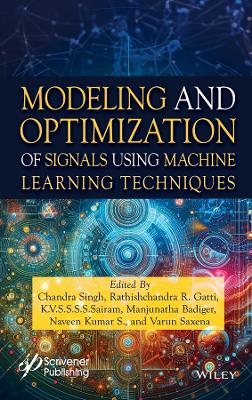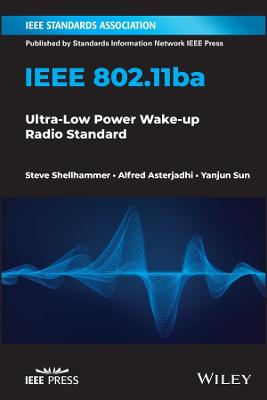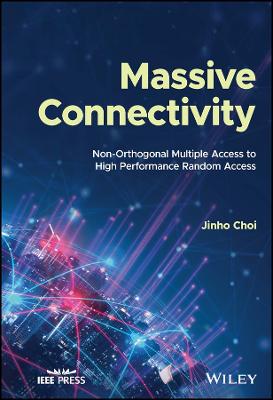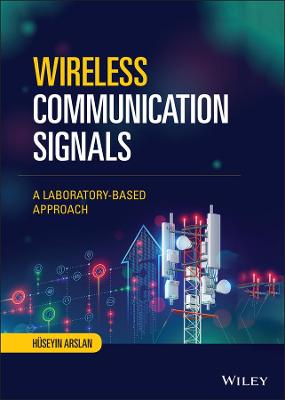5G Technology
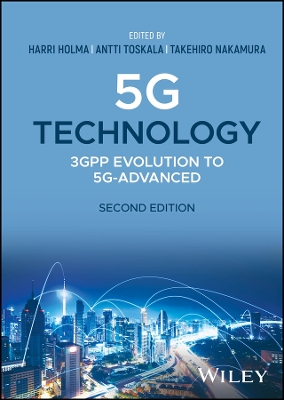 -15%
portes grátis
-15%
portes grátis
5G Technology
3GPP Evolution to 5G-Advanced
Nakamura, Takehiro; Toskala, Antti; Holma, Harri
John Wiley & Sons Inc
03/2024
656
Dura
Inglês
9781119816034
15 a 20 dias
Descrição não disponível.
About the Editors xxi
List of Contributors xxiii
Foreword xxv
Preface xxvii
Acknowledgment xxix
1 Introduction 1
Harri Holma, Antti Toskala, Takehiro Nakamura, and Tommi Uitto
1.1 Introduction 1
1.2 5G Targets 3
1.3 5G Technology Components 3
1.4 5G Spectrum 4
1.5 5G Capabilities 6
1.6 5G Capacity Boost 7
1.7 5G Standardization and Schedule 8
1.8 5G Use Cases 9
1.9 Evolution Path from LTE to 5G 10
1.10 5G-Advanced 10
1.11 Summary 11
2 5G Targets and Standardization 13
Hiroyuki Atarashi, Mikio Iwamura, Satoshi Nagata, Takehiro Nakamura, and Antti Toskala
2.1 Introduction 13
2.2 Itu 13
2.3 Ngmn 17
2.4 3GPP Schedule and Phasing 22
2.5 Evolution Towards 5G-Advanced and 6G 25
3 Technology Components 27
Harri Holma
3.1 Introduction 27
3.2 Spectrum Utilization 27
3.3 Beamforming 31
3.4 Flexible Physical Layer and Protocols 33
3.5 Network Slicing 44
3.6 Dual Connectivity with LTE 44
3.7 Radio Cloud and Edge Computing 46
3.8 Summary 47
4 Spectrum 49
Harri Holma and Takehiro Nakamura
4.1 Introduction 49
4.2 Millimeter Wave Spectrum Above 20 GHz 52
4.3 Mid-Band Spectrum at 3.3-5.0 GHz and at 2.6 GHz 55
4.4 Low-Band Spectrum Below 3 GHz 58
4.5 Unlicensed Band 59
4.6 Shared Band 62
4.7 3GPP Frequency Variants 64
4.8 Summary 64
5 5GArchitecture 67
Antti Toskala and Miikka Poikselkae
5.1 Introduction 67
5.2 5G Architecture Options 67
5.3 5G Core Network Architecture 70
5.4 5G RAN Architecture 75
5.5 Network Slicing 81
5.6 Summary 85
6 5G Physical Layer 87
Mihai Enescu, Keeth Jayasinghe, Karri Ranta-Aho, Karol Schober, and Antti Toskala
6.1 Introduction 87
6.2 5G Multiple Access Principle 88
6.3 Physical Channels and Signals 92
6.4 Basic Structures for 5G Frame Structure 95
6.5 5G Channel Structures and Beamforming Basics 98
6.6 Random Access 100
6.7 Downlink User Data Transmission 101
6.8 Uplink User Data Transmission 103
6.9 Uplink Signaling Transmission 105
6.10 Downlink Signaling Transmission 108
6.11 Physical Layer Procedures 111
6.12 5G MIMO and Beamforming Operation 113
6.13 Channel Coding with 5G 133
6.14 Dual Connectivity 142
6.15 5G Data Rates 144
6.16 Physical Layer Measurements 145
6.17 UE Capability 146
6.18 Summary 147
7 5G Radio Protocols 149
Tero Henttonen, Jarkko Koskela, Benoist Sebire, and Antti Toskala
7.1 Introduction 149
7.2 5G Radio Protocol Layers 150
7.3 Sdap 151
7.4 Pdcp 156
7.5 Rlc 160
7.6 MAC Layer 162
7.7 The RRC Protocol 168
7.8 Radio Protocols in RAN Architecture 185
7.9 Summary 185
8 Deployment Aspects 187
Harri Holma, Riku Luostari, Jussi Reunanen, and Puripong Thepchatri
8.1 Introduction 187
8.2 Spectrum Resources 188
8.3 Network Density 190
8.4 Mobile Data Traffic Growth 190
8.5 Base Station Site Solutions 192
8.6 Electromagnetic Field (EMF) Considerations 194
8.7 Network Synchronization and Coordination Requirements 195
8.8 5G Overlay with Another Vendor LTE 209
8.9 Summary 210
9 Transport 213
Esa Markus Metsaelae and Juha Salmelin
9.1 5G Transport Network 213
9.2 Capacity and Latency 219
9.3 Technologies 225
9.4 Fronthaul and Backhaul Interfaces 228
9.5 Specific Topics 232
10 5G Performance 239
Harri Holma, Suresh Kalyanasundaram, and Venkat Venkatesan
10.1 Introduction 239
10.2 Peak Data Rates 241
10.3 Practical Data Rates 243
10.4 Latency 247
10.5 Link Budgets 257
10.6 Coverage for Sub-6-GHz Band 262
10.7 Massive MIMO and Beamforming Algorithms 269
10.8 Packet Scheduling Algorithms 280
10.9 Spectral Efficiency and Capacity 286
10.10 Network Energy Efficiency 291
10.11 Traffic and Device Density 294
10.12 Ultra-Reliability for Mission-Critical Communication 296
10.13 Mobility and High-Speed Trains 299
10.14 Summary 302
11 Measurements 305
Yoshihisa Kishiyama and Tetsuro Imai
11.1 Introduction 305
11.2 Propagation Measurements Above 6 GHz 306
11.3 Field Experiments with Sub-6-GHz 5G Radio 326
11.4 Field Experiments of Millimeter Wave 5G Radio 332
11.5 Summary 344
12 5G RF Design Challenges 349
Petri Vasenkari, Dominique Brunel, and Laurent Noel
12.1 Introduction 349
12.2 Impact of New Physical Layer on RF Performance 350
12.3 5G Standalone Performance Aspects in Frequency Range 1 363
12.4 5G Standalone Performance Aspects in mmWave Frequency Range 2 373
12.5 Dual Uplink Performance Challenges for NSA Operation 381
12.6 Examples of UE Implementation Challenges 392
12.7 Summary 396
13 5G Modem Design Challenges 399
YihShen Chen, Jiann-Ching Guey, Chienhwa Hwang, PeiKai Liao, Guillaume Sebire, Weide Wu, and Weidong Yang
13.1 Introduction 399
13.2 High Data Rate, System Flexibility, and Computational Complexity 401
13.3 Low Latency, Flexible Timing, and Modem Control Flow Complexity 406
13.4 Multi-RAT Coexistence and Modem Architecture 413
13.5 Wider Bandwidth Operation and Modem Power Consumption 419
13.6 Summary 428
14 Internet of Things Optimization 431
Harri Holma, Rapeepat Ratasuk, and Mads Lauridsen
14.1 Introduction 431
14.2 IoT Optimization in LTE Radio 433
14.3 Lte-m 436
14.4 Narrowband-IoT 439
14.5 IoT Optimization in LTE Core Network 442
14.6 Coverage 443
14.7 Delay and Capacity 444
14.8 Power Saving Features 446
14.9 NB-IoT Power Consumption Measurements 448
14.10 IoT Solution Benchmarking 449
14.11 IoT Optimizations in 5G 451
14.12 Summary 458
15 LTE-Advanced Evolution 461
Harri Holma and Timo Lunttila
15.1 Introduction 461
15.2 Overview of LTE Evolution 462
15.3 LTE-Advanced Pro Technologies 465
15.4 5G and LTE Benchmarking 478
15.5 Summary 482
16 5G-Advanced Overview 485
Antti Toskala and Harri Holma
16.1 Introduction 485
16.2 3GPP Schedule 486
16.3 5G-Advanced Key Areas 486
16.4 Extended and Augmented Reality 488
16.5 Superaccurate Positioning 490
16.6 Radio Performance Boosters 491
16.7 New Vertical Use Cases 493
16.8 Resilient Timing 494
16.9 Network Automation and Energy Efficiency 495
16.10 RedCap/NR-Light for IoT 495
16.11 Outlook For 5G Release 19 496
16.12 Outlook For 6G 497
16.13 Summary 502
17 Radio Enhancements in Release 16-18 505
Harri Holma and Antti Toskala
17.1 Introduction 505
17.2 Coverage Enhancements 505
17.3 MIMO Enhancements 508
17.4 Mobility 510
17.5 UE Power Saving 511
17.6 AI/ML for Air Interface and NG-RAN 513
17.7 Integrated Access and Backhaul 515
17.8 Dual Connectivity and Carrier Aggregation Enhancements 517
17.9 Small Data Transmission 518
17.10 Conclusion 519
18 Industrial Internet of Things 521
Harri Holma and Antti Toskala
18.1 Introduction 521
18.2 Reduced Capability (RedCap) Devices 522
18.3 RedCap Device Complexity 523
18.4 RedCap Device Power Consumption 525
18.5 RedCap Benchmarking with LTE-Based IoT 526
18.6 New Spectrum Options 527
18.7 Ultra-reliable Low Latency Communication 528
18.8 Low Latency Communication 530
18.9 Ultra-Reliable Communication 537
18.10 Time Sensitive Network 540
18.11 LAN Service 541
18.12 Positioning Solutions 542
18.13 Non-Public Networks 543
18.14 Summary 544
19 Verticals 547
Antti Toskala and Harri Holma
19.1 Introduction 547
19.2 Non-Terrestrial Networks (NTN) 547
19.3 High Altitude Platform Stations (HAPS) 550
19.4 Drones 551
19.5 Vehicle Connectivity 552
19.6 Public Safety 553
19.7 Dedicated Networks with less than 5 MHz of Spectrum 554
19.8 Unlicensed 555
19.9 Summary 556
20 Open RAN and Virtualized RAN 559
Harri Holma and Antti Toskala
20.1 Introduction 559
20.2 Radio Network Architecture Trends 560
20.3 Open RAN Fronthaul 561
20.4 Uplink Capacity Optimization 565
20.5 O-RAN Alliance 566
20.6 O-RAN Fronthaul 566
20.7 Open Test and Integration Center and PlugFests 568
20.8 O-RAN Security and Orchestration 569
20.9 Baseband Virtualization and Cloud Ran 569
20.10 Baseband Virtualization and Centralization 570
20.11 Far Edge Availability and Network Topology 571
20.12 Fiber and Optics Availability 573
20.13 Baseband Hardware Efficiency 574
20.14 Virtual RAN Evolution 575
20.15 RAN Intelligent Controller 575
20.16 Summary 577
21 Machine Learning for 5G System Optimization 579
Riku Luostari, Petteri Kela, Mikko Honkala, Dani Korpi, Janne Huttunen, and Harri Holma
21.1 Introduction 580
21.2 Motivation 580
21.3 Model Training and Inference in Wireless Systems 581
21.4 Machine Learning Categories 582
21.5 Key Algorithm Techniques 583
21.6 Machine Learning for 5G Wireless Systems 584
21.7 Channel State Information (CSI) Improvement and Channel Prediction 586
21.8 Deep Neural Network-Based Receivers and DeepRx 587
21.9 Pilotless OFDM 590
21.10 Massive MIMO, Beamforming, and DeepTx 591
21.11 Beam Tracking for mmWaves 593
21.12 Channel Coding 593
21.13 MAC Scheduler and Radio Resource Management 594
21.14 Learned Communication Protocols 601
21.15 Network Planning and Optimization 602
21.16 Network Operations 604
21.17 Network Security 604
21.18 Positioning 605
21.19 Challenges 606
21.20 Scalability 606
21.21 Uncertainty 606
21.22 Time Criticality and Computational Requirements 606
21.23 Standardization and Specifications Impact 607
21.24 Summary 608
References 609
Index 613
List of Contributors xxiii
Foreword xxv
Preface xxvii
Acknowledgment xxix
1 Introduction 1
Harri Holma, Antti Toskala, Takehiro Nakamura, and Tommi Uitto
1.1 Introduction 1
1.2 5G Targets 3
1.3 5G Technology Components 3
1.4 5G Spectrum 4
1.5 5G Capabilities 6
1.6 5G Capacity Boost 7
1.7 5G Standardization and Schedule 8
1.8 5G Use Cases 9
1.9 Evolution Path from LTE to 5G 10
1.10 5G-Advanced 10
1.11 Summary 11
2 5G Targets and Standardization 13
Hiroyuki Atarashi, Mikio Iwamura, Satoshi Nagata, Takehiro Nakamura, and Antti Toskala
2.1 Introduction 13
2.2 Itu 13
2.3 Ngmn 17
2.4 3GPP Schedule and Phasing 22
2.5 Evolution Towards 5G-Advanced and 6G 25
3 Technology Components 27
Harri Holma
3.1 Introduction 27
3.2 Spectrum Utilization 27
3.3 Beamforming 31
3.4 Flexible Physical Layer and Protocols 33
3.5 Network Slicing 44
3.6 Dual Connectivity with LTE 44
3.7 Radio Cloud and Edge Computing 46
3.8 Summary 47
4 Spectrum 49
Harri Holma and Takehiro Nakamura
4.1 Introduction 49
4.2 Millimeter Wave Spectrum Above 20 GHz 52
4.3 Mid-Band Spectrum at 3.3-5.0 GHz and at 2.6 GHz 55
4.4 Low-Band Spectrum Below 3 GHz 58
4.5 Unlicensed Band 59
4.6 Shared Band 62
4.7 3GPP Frequency Variants 64
4.8 Summary 64
5 5GArchitecture 67
Antti Toskala and Miikka Poikselkae
5.1 Introduction 67
5.2 5G Architecture Options 67
5.3 5G Core Network Architecture 70
5.4 5G RAN Architecture 75
5.5 Network Slicing 81
5.6 Summary 85
6 5G Physical Layer 87
Mihai Enescu, Keeth Jayasinghe, Karri Ranta-Aho, Karol Schober, and Antti Toskala
6.1 Introduction 87
6.2 5G Multiple Access Principle 88
6.3 Physical Channels and Signals 92
6.4 Basic Structures for 5G Frame Structure 95
6.5 5G Channel Structures and Beamforming Basics 98
6.6 Random Access 100
6.7 Downlink User Data Transmission 101
6.8 Uplink User Data Transmission 103
6.9 Uplink Signaling Transmission 105
6.10 Downlink Signaling Transmission 108
6.11 Physical Layer Procedures 111
6.12 5G MIMO and Beamforming Operation 113
6.13 Channel Coding with 5G 133
6.14 Dual Connectivity 142
6.15 5G Data Rates 144
6.16 Physical Layer Measurements 145
6.17 UE Capability 146
6.18 Summary 147
7 5G Radio Protocols 149
Tero Henttonen, Jarkko Koskela, Benoist Sebire, and Antti Toskala
7.1 Introduction 149
7.2 5G Radio Protocol Layers 150
7.3 Sdap 151
7.4 Pdcp 156
7.5 Rlc 160
7.6 MAC Layer 162
7.7 The RRC Protocol 168
7.8 Radio Protocols in RAN Architecture 185
7.9 Summary 185
8 Deployment Aspects 187
Harri Holma, Riku Luostari, Jussi Reunanen, and Puripong Thepchatri
8.1 Introduction 187
8.2 Spectrum Resources 188
8.3 Network Density 190
8.4 Mobile Data Traffic Growth 190
8.5 Base Station Site Solutions 192
8.6 Electromagnetic Field (EMF) Considerations 194
8.7 Network Synchronization and Coordination Requirements 195
8.8 5G Overlay with Another Vendor LTE 209
8.9 Summary 210
9 Transport 213
Esa Markus Metsaelae and Juha Salmelin
9.1 5G Transport Network 213
9.2 Capacity and Latency 219
9.3 Technologies 225
9.4 Fronthaul and Backhaul Interfaces 228
9.5 Specific Topics 232
10 5G Performance 239
Harri Holma, Suresh Kalyanasundaram, and Venkat Venkatesan
10.1 Introduction 239
10.2 Peak Data Rates 241
10.3 Practical Data Rates 243
10.4 Latency 247
10.5 Link Budgets 257
10.6 Coverage for Sub-6-GHz Band 262
10.7 Massive MIMO and Beamforming Algorithms 269
10.8 Packet Scheduling Algorithms 280
10.9 Spectral Efficiency and Capacity 286
10.10 Network Energy Efficiency 291
10.11 Traffic and Device Density 294
10.12 Ultra-Reliability for Mission-Critical Communication 296
10.13 Mobility and High-Speed Trains 299
10.14 Summary 302
11 Measurements 305
Yoshihisa Kishiyama and Tetsuro Imai
11.1 Introduction 305
11.2 Propagation Measurements Above 6 GHz 306
11.3 Field Experiments with Sub-6-GHz 5G Radio 326
11.4 Field Experiments of Millimeter Wave 5G Radio 332
11.5 Summary 344
12 5G RF Design Challenges 349
Petri Vasenkari, Dominique Brunel, and Laurent Noel
12.1 Introduction 349
12.2 Impact of New Physical Layer on RF Performance 350
12.3 5G Standalone Performance Aspects in Frequency Range 1 363
12.4 5G Standalone Performance Aspects in mmWave Frequency Range 2 373
12.5 Dual Uplink Performance Challenges for NSA Operation 381
12.6 Examples of UE Implementation Challenges 392
12.7 Summary 396
13 5G Modem Design Challenges 399
YihShen Chen, Jiann-Ching Guey, Chienhwa Hwang, PeiKai Liao, Guillaume Sebire, Weide Wu, and Weidong Yang
13.1 Introduction 399
13.2 High Data Rate, System Flexibility, and Computational Complexity 401
13.3 Low Latency, Flexible Timing, and Modem Control Flow Complexity 406
13.4 Multi-RAT Coexistence and Modem Architecture 413
13.5 Wider Bandwidth Operation and Modem Power Consumption 419
13.6 Summary 428
14 Internet of Things Optimization 431
Harri Holma, Rapeepat Ratasuk, and Mads Lauridsen
14.1 Introduction 431
14.2 IoT Optimization in LTE Radio 433
14.3 Lte-m 436
14.4 Narrowband-IoT 439
14.5 IoT Optimization in LTE Core Network 442
14.6 Coverage 443
14.7 Delay and Capacity 444
14.8 Power Saving Features 446
14.9 NB-IoT Power Consumption Measurements 448
14.10 IoT Solution Benchmarking 449
14.11 IoT Optimizations in 5G 451
14.12 Summary 458
15 LTE-Advanced Evolution 461
Harri Holma and Timo Lunttila
15.1 Introduction 461
15.2 Overview of LTE Evolution 462
15.3 LTE-Advanced Pro Technologies 465
15.4 5G and LTE Benchmarking 478
15.5 Summary 482
16 5G-Advanced Overview 485
Antti Toskala and Harri Holma
16.1 Introduction 485
16.2 3GPP Schedule 486
16.3 5G-Advanced Key Areas 486
16.4 Extended and Augmented Reality 488
16.5 Superaccurate Positioning 490
16.6 Radio Performance Boosters 491
16.7 New Vertical Use Cases 493
16.8 Resilient Timing 494
16.9 Network Automation and Energy Efficiency 495
16.10 RedCap/NR-Light for IoT 495
16.11 Outlook For 5G Release 19 496
16.12 Outlook For 6G 497
16.13 Summary 502
17 Radio Enhancements in Release 16-18 505
Harri Holma and Antti Toskala
17.1 Introduction 505
17.2 Coverage Enhancements 505
17.3 MIMO Enhancements 508
17.4 Mobility 510
17.5 UE Power Saving 511
17.6 AI/ML for Air Interface and NG-RAN 513
17.7 Integrated Access and Backhaul 515
17.8 Dual Connectivity and Carrier Aggregation Enhancements 517
17.9 Small Data Transmission 518
17.10 Conclusion 519
18 Industrial Internet of Things 521
Harri Holma and Antti Toskala
18.1 Introduction 521
18.2 Reduced Capability (RedCap) Devices 522
18.3 RedCap Device Complexity 523
18.4 RedCap Device Power Consumption 525
18.5 RedCap Benchmarking with LTE-Based IoT 526
18.6 New Spectrum Options 527
18.7 Ultra-reliable Low Latency Communication 528
18.8 Low Latency Communication 530
18.9 Ultra-Reliable Communication 537
18.10 Time Sensitive Network 540
18.11 LAN Service 541
18.12 Positioning Solutions 542
18.13 Non-Public Networks 543
18.14 Summary 544
19 Verticals 547
Antti Toskala and Harri Holma
19.1 Introduction 547
19.2 Non-Terrestrial Networks (NTN) 547
19.3 High Altitude Platform Stations (HAPS) 550
19.4 Drones 551
19.5 Vehicle Connectivity 552
19.6 Public Safety 553
19.7 Dedicated Networks with less than 5 MHz of Spectrum 554
19.8 Unlicensed 555
19.9 Summary 556
20 Open RAN and Virtualized RAN 559
Harri Holma and Antti Toskala
20.1 Introduction 559
20.2 Radio Network Architecture Trends 560
20.3 Open RAN Fronthaul 561
20.4 Uplink Capacity Optimization 565
20.5 O-RAN Alliance 566
20.6 O-RAN Fronthaul 566
20.7 Open Test and Integration Center and PlugFests 568
20.8 O-RAN Security and Orchestration 569
20.9 Baseband Virtualization and Cloud Ran 569
20.10 Baseband Virtualization and Centralization 570
20.11 Far Edge Availability and Network Topology 571
20.12 Fiber and Optics Availability 573
20.13 Baseband Hardware Efficiency 574
20.14 Virtual RAN Evolution 575
20.15 RAN Intelligent Controller 575
20.16 Summary 577
21 Machine Learning for 5G System Optimization 579
Riku Luostari, Petteri Kela, Mikko Honkala, Dani Korpi, Janne Huttunen, and Harri Holma
21.1 Introduction 580
21.2 Motivation 580
21.3 Model Training and Inference in Wireless Systems 581
21.4 Machine Learning Categories 582
21.5 Key Algorithm Techniques 583
21.6 Machine Learning for 5G Wireless Systems 584
21.7 Channel State Information (CSI) Improvement and Channel Prediction 586
21.8 Deep Neural Network-Based Receivers and DeepRx 587
21.9 Pilotless OFDM 590
21.10 Massive MIMO, Beamforming, and DeepTx 591
21.11 Beam Tracking for mmWaves 593
21.12 Channel Coding 593
21.13 MAC Scheduler and Radio Resource Management 594
21.14 Learned Communication Protocols 601
21.15 Network Planning and Optimization 602
21.16 Network Operations 604
21.17 Network Security 604
21.18 Positioning 605
21.19 Challenges 606
21.20 Scalability 606
21.21 Uncertainty 606
21.22 Time Criticality and Computational Requirements 606
21.23 Standardization and Specifications Impact 607
21.24 Summary 608
References 609
Index 613
Este título pertence ao(s) assunto(s) indicados(s). Para ver outros títulos clique no assunto desejado.
5G; 5G technology; 5G spectrum options; 5G antenna structures; 5G physical layer and protocols designs; 5G network architectures; o-ran; industrial iot; 5G 17; 5G Radio Enhancements in Releases 16 and 17; Open RAN and Virtualized RAN; 5G Verticals and New Use Cases; 5G Outlook for Release 18; 5G procedures; 5G performance
About the Editors xxi
List of Contributors xxiii
Foreword xxv
Preface xxvii
Acknowledgment xxix
1 Introduction 1
Harri Holma, Antti Toskala, Takehiro Nakamura, and Tommi Uitto
1.1 Introduction 1
1.2 5G Targets 3
1.3 5G Technology Components 3
1.4 5G Spectrum 4
1.5 5G Capabilities 6
1.6 5G Capacity Boost 7
1.7 5G Standardization and Schedule 8
1.8 5G Use Cases 9
1.9 Evolution Path from LTE to 5G 10
1.10 5G-Advanced 10
1.11 Summary 11
2 5G Targets and Standardization 13
Hiroyuki Atarashi, Mikio Iwamura, Satoshi Nagata, Takehiro Nakamura, and Antti Toskala
2.1 Introduction 13
2.2 Itu 13
2.3 Ngmn 17
2.4 3GPP Schedule and Phasing 22
2.5 Evolution Towards 5G-Advanced and 6G 25
3 Technology Components 27
Harri Holma
3.1 Introduction 27
3.2 Spectrum Utilization 27
3.3 Beamforming 31
3.4 Flexible Physical Layer and Protocols 33
3.5 Network Slicing 44
3.6 Dual Connectivity with LTE 44
3.7 Radio Cloud and Edge Computing 46
3.8 Summary 47
4 Spectrum 49
Harri Holma and Takehiro Nakamura
4.1 Introduction 49
4.2 Millimeter Wave Spectrum Above 20 GHz 52
4.3 Mid-Band Spectrum at 3.3-5.0 GHz and at 2.6 GHz 55
4.4 Low-Band Spectrum Below 3 GHz 58
4.5 Unlicensed Band 59
4.6 Shared Band 62
4.7 3GPP Frequency Variants 64
4.8 Summary 64
5 5GArchitecture 67
Antti Toskala and Miikka Poikselkae
5.1 Introduction 67
5.2 5G Architecture Options 67
5.3 5G Core Network Architecture 70
5.4 5G RAN Architecture 75
5.5 Network Slicing 81
5.6 Summary 85
6 5G Physical Layer 87
Mihai Enescu, Keeth Jayasinghe, Karri Ranta-Aho, Karol Schober, and Antti Toskala
6.1 Introduction 87
6.2 5G Multiple Access Principle 88
6.3 Physical Channels and Signals 92
6.4 Basic Structures for 5G Frame Structure 95
6.5 5G Channel Structures and Beamforming Basics 98
6.6 Random Access 100
6.7 Downlink User Data Transmission 101
6.8 Uplink User Data Transmission 103
6.9 Uplink Signaling Transmission 105
6.10 Downlink Signaling Transmission 108
6.11 Physical Layer Procedures 111
6.12 5G MIMO and Beamforming Operation 113
6.13 Channel Coding with 5G 133
6.14 Dual Connectivity 142
6.15 5G Data Rates 144
6.16 Physical Layer Measurements 145
6.17 UE Capability 146
6.18 Summary 147
7 5G Radio Protocols 149
Tero Henttonen, Jarkko Koskela, Benoist Sebire, and Antti Toskala
7.1 Introduction 149
7.2 5G Radio Protocol Layers 150
7.3 Sdap 151
7.4 Pdcp 156
7.5 Rlc 160
7.6 MAC Layer 162
7.7 The RRC Protocol 168
7.8 Radio Protocols in RAN Architecture 185
7.9 Summary 185
8 Deployment Aspects 187
Harri Holma, Riku Luostari, Jussi Reunanen, and Puripong Thepchatri
8.1 Introduction 187
8.2 Spectrum Resources 188
8.3 Network Density 190
8.4 Mobile Data Traffic Growth 190
8.5 Base Station Site Solutions 192
8.6 Electromagnetic Field (EMF) Considerations 194
8.7 Network Synchronization and Coordination Requirements 195
8.8 5G Overlay with Another Vendor LTE 209
8.9 Summary 210
9 Transport 213
Esa Markus Metsaelae and Juha Salmelin
9.1 5G Transport Network 213
9.2 Capacity and Latency 219
9.3 Technologies 225
9.4 Fronthaul and Backhaul Interfaces 228
9.5 Specific Topics 232
10 5G Performance 239
Harri Holma, Suresh Kalyanasundaram, and Venkat Venkatesan
10.1 Introduction 239
10.2 Peak Data Rates 241
10.3 Practical Data Rates 243
10.4 Latency 247
10.5 Link Budgets 257
10.6 Coverage for Sub-6-GHz Band 262
10.7 Massive MIMO and Beamforming Algorithms 269
10.8 Packet Scheduling Algorithms 280
10.9 Spectral Efficiency and Capacity 286
10.10 Network Energy Efficiency 291
10.11 Traffic and Device Density 294
10.12 Ultra-Reliability for Mission-Critical Communication 296
10.13 Mobility and High-Speed Trains 299
10.14 Summary 302
11 Measurements 305
Yoshihisa Kishiyama and Tetsuro Imai
11.1 Introduction 305
11.2 Propagation Measurements Above 6 GHz 306
11.3 Field Experiments with Sub-6-GHz 5G Radio 326
11.4 Field Experiments of Millimeter Wave 5G Radio 332
11.5 Summary 344
12 5G RF Design Challenges 349
Petri Vasenkari, Dominique Brunel, and Laurent Noel
12.1 Introduction 349
12.2 Impact of New Physical Layer on RF Performance 350
12.3 5G Standalone Performance Aspects in Frequency Range 1 363
12.4 5G Standalone Performance Aspects in mmWave Frequency Range 2 373
12.5 Dual Uplink Performance Challenges for NSA Operation 381
12.6 Examples of UE Implementation Challenges 392
12.7 Summary 396
13 5G Modem Design Challenges 399
YihShen Chen, Jiann-Ching Guey, Chienhwa Hwang, PeiKai Liao, Guillaume Sebire, Weide Wu, and Weidong Yang
13.1 Introduction 399
13.2 High Data Rate, System Flexibility, and Computational Complexity 401
13.3 Low Latency, Flexible Timing, and Modem Control Flow Complexity 406
13.4 Multi-RAT Coexistence and Modem Architecture 413
13.5 Wider Bandwidth Operation and Modem Power Consumption 419
13.6 Summary 428
14 Internet of Things Optimization 431
Harri Holma, Rapeepat Ratasuk, and Mads Lauridsen
14.1 Introduction 431
14.2 IoT Optimization in LTE Radio 433
14.3 Lte-m 436
14.4 Narrowband-IoT 439
14.5 IoT Optimization in LTE Core Network 442
14.6 Coverage 443
14.7 Delay and Capacity 444
14.8 Power Saving Features 446
14.9 NB-IoT Power Consumption Measurements 448
14.10 IoT Solution Benchmarking 449
14.11 IoT Optimizations in 5G 451
14.12 Summary 458
15 LTE-Advanced Evolution 461
Harri Holma and Timo Lunttila
15.1 Introduction 461
15.2 Overview of LTE Evolution 462
15.3 LTE-Advanced Pro Technologies 465
15.4 5G and LTE Benchmarking 478
15.5 Summary 482
16 5G-Advanced Overview 485
Antti Toskala and Harri Holma
16.1 Introduction 485
16.2 3GPP Schedule 486
16.3 5G-Advanced Key Areas 486
16.4 Extended and Augmented Reality 488
16.5 Superaccurate Positioning 490
16.6 Radio Performance Boosters 491
16.7 New Vertical Use Cases 493
16.8 Resilient Timing 494
16.9 Network Automation and Energy Efficiency 495
16.10 RedCap/NR-Light for IoT 495
16.11 Outlook For 5G Release 19 496
16.12 Outlook For 6G 497
16.13 Summary 502
17 Radio Enhancements in Release 16-18 505
Harri Holma and Antti Toskala
17.1 Introduction 505
17.2 Coverage Enhancements 505
17.3 MIMO Enhancements 508
17.4 Mobility 510
17.5 UE Power Saving 511
17.6 AI/ML for Air Interface and NG-RAN 513
17.7 Integrated Access and Backhaul 515
17.8 Dual Connectivity and Carrier Aggregation Enhancements 517
17.9 Small Data Transmission 518
17.10 Conclusion 519
18 Industrial Internet of Things 521
Harri Holma and Antti Toskala
18.1 Introduction 521
18.2 Reduced Capability (RedCap) Devices 522
18.3 RedCap Device Complexity 523
18.4 RedCap Device Power Consumption 525
18.5 RedCap Benchmarking with LTE-Based IoT 526
18.6 New Spectrum Options 527
18.7 Ultra-reliable Low Latency Communication 528
18.8 Low Latency Communication 530
18.9 Ultra-Reliable Communication 537
18.10 Time Sensitive Network 540
18.11 LAN Service 541
18.12 Positioning Solutions 542
18.13 Non-Public Networks 543
18.14 Summary 544
19 Verticals 547
Antti Toskala and Harri Holma
19.1 Introduction 547
19.2 Non-Terrestrial Networks (NTN) 547
19.3 High Altitude Platform Stations (HAPS) 550
19.4 Drones 551
19.5 Vehicle Connectivity 552
19.6 Public Safety 553
19.7 Dedicated Networks with less than 5 MHz of Spectrum 554
19.8 Unlicensed 555
19.9 Summary 556
20 Open RAN and Virtualized RAN 559
Harri Holma and Antti Toskala
20.1 Introduction 559
20.2 Radio Network Architecture Trends 560
20.3 Open RAN Fronthaul 561
20.4 Uplink Capacity Optimization 565
20.5 O-RAN Alliance 566
20.6 O-RAN Fronthaul 566
20.7 Open Test and Integration Center and PlugFests 568
20.8 O-RAN Security and Orchestration 569
20.9 Baseband Virtualization and Cloud Ran 569
20.10 Baseband Virtualization and Centralization 570
20.11 Far Edge Availability and Network Topology 571
20.12 Fiber and Optics Availability 573
20.13 Baseband Hardware Efficiency 574
20.14 Virtual RAN Evolution 575
20.15 RAN Intelligent Controller 575
20.16 Summary 577
21 Machine Learning for 5G System Optimization 579
Riku Luostari, Petteri Kela, Mikko Honkala, Dani Korpi, Janne Huttunen, and Harri Holma
21.1 Introduction 580
21.2 Motivation 580
21.3 Model Training and Inference in Wireless Systems 581
21.4 Machine Learning Categories 582
21.5 Key Algorithm Techniques 583
21.6 Machine Learning for 5G Wireless Systems 584
21.7 Channel State Information (CSI) Improvement and Channel Prediction 586
21.8 Deep Neural Network-Based Receivers and DeepRx 587
21.9 Pilotless OFDM 590
21.10 Massive MIMO, Beamforming, and DeepTx 591
21.11 Beam Tracking for mmWaves 593
21.12 Channel Coding 593
21.13 MAC Scheduler and Radio Resource Management 594
21.14 Learned Communication Protocols 601
21.15 Network Planning and Optimization 602
21.16 Network Operations 604
21.17 Network Security 604
21.18 Positioning 605
21.19 Challenges 606
21.20 Scalability 606
21.21 Uncertainty 606
21.22 Time Criticality and Computational Requirements 606
21.23 Standardization and Specifications Impact 607
21.24 Summary 608
References 609
Index 613
List of Contributors xxiii
Foreword xxv
Preface xxvii
Acknowledgment xxix
1 Introduction 1
Harri Holma, Antti Toskala, Takehiro Nakamura, and Tommi Uitto
1.1 Introduction 1
1.2 5G Targets 3
1.3 5G Technology Components 3
1.4 5G Spectrum 4
1.5 5G Capabilities 6
1.6 5G Capacity Boost 7
1.7 5G Standardization and Schedule 8
1.8 5G Use Cases 9
1.9 Evolution Path from LTE to 5G 10
1.10 5G-Advanced 10
1.11 Summary 11
2 5G Targets and Standardization 13
Hiroyuki Atarashi, Mikio Iwamura, Satoshi Nagata, Takehiro Nakamura, and Antti Toskala
2.1 Introduction 13
2.2 Itu 13
2.3 Ngmn 17
2.4 3GPP Schedule and Phasing 22
2.5 Evolution Towards 5G-Advanced and 6G 25
3 Technology Components 27
Harri Holma
3.1 Introduction 27
3.2 Spectrum Utilization 27
3.3 Beamforming 31
3.4 Flexible Physical Layer and Protocols 33
3.5 Network Slicing 44
3.6 Dual Connectivity with LTE 44
3.7 Radio Cloud and Edge Computing 46
3.8 Summary 47
4 Spectrum 49
Harri Holma and Takehiro Nakamura
4.1 Introduction 49
4.2 Millimeter Wave Spectrum Above 20 GHz 52
4.3 Mid-Band Spectrum at 3.3-5.0 GHz and at 2.6 GHz 55
4.4 Low-Band Spectrum Below 3 GHz 58
4.5 Unlicensed Band 59
4.6 Shared Band 62
4.7 3GPP Frequency Variants 64
4.8 Summary 64
5 5GArchitecture 67
Antti Toskala and Miikka Poikselkae
5.1 Introduction 67
5.2 5G Architecture Options 67
5.3 5G Core Network Architecture 70
5.4 5G RAN Architecture 75
5.5 Network Slicing 81
5.6 Summary 85
6 5G Physical Layer 87
Mihai Enescu, Keeth Jayasinghe, Karri Ranta-Aho, Karol Schober, and Antti Toskala
6.1 Introduction 87
6.2 5G Multiple Access Principle 88
6.3 Physical Channels and Signals 92
6.4 Basic Structures for 5G Frame Structure 95
6.5 5G Channel Structures and Beamforming Basics 98
6.6 Random Access 100
6.7 Downlink User Data Transmission 101
6.8 Uplink User Data Transmission 103
6.9 Uplink Signaling Transmission 105
6.10 Downlink Signaling Transmission 108
6.11 Physical Layer Procedures 111
6.12 5G MIMO and Beamforming Operation 113
6.13 Channel Coding with 5G 133
6.14 Dual Connectivity 142
6.15 5G Data Rates 144
6.16 Physical Layer Measurements 145
6.17 UE Capability 146
6.18 Summary 147
7 5G Radio Protocols 149
Tero Henttonen, Jarkko Koskela, Benoist Sebire, and Antti Toskala
7.1 Introduction 149
7.2 5G Radio Protocol Layers 150
7.3 Sdap 151
7.4 Pdcp 156
7.5 Rlc 160
7.6 MAC Layer 162
7.7 The RRC Protocol 168
7.8 Radio Protocols in RAN Architecture 185
7.9 Summary 185
8 Deployment Aspects 187
Harri Holma, Riku Luostari, Jussi Reunanen, and Puripong Thepchatri
8.1 Introduction 187
8.2 Spectrum Resources 188
8.3 Network Density 190
8.4 Mobile Data Traffic Growth 190
8.5 Base Station Site Solutions 192
8.6 Electromagnetic Field (EMF) Considerations 194
8.7 Network Synchronization and Coordination Requirements 195
8.8 5G Overlay with Another Vendor LTE 209
8.9 Summary 210
9 Transport 213
Esa Markus Metsaelae and Juha Salmelin
9.1 5G Transport Network 213
9.2 Capacity and Latency 219
9.3 Technologies 225
9.4 Fronthaul and Backhaul Interfaces 228
9.5 Specific Topics 232
10 5G Performance 239
Harri Holma, Suresh Kalyanasundaram, and Venkat Venkatesan
10.1 Introduction 239
10.2 Peak Data Rates 241
10.3 Practical Data Rates 243
10.4 Latency 247
10.5 Link Budgets 257
10.6 Coverage for Sub-6-GHz Band 262
10.7 Massive MIMO and Beamforming Algorithms 269
10.8 Packet Scheduling Algorithms 280
10.9 Spectral Efficiency and Capacity 286
10.10 Network Energy Efficiency 291
10.11 Traffic and Device Density 294
10.12 Ultra-Reliability for Mission-Critical Communication 296
10.13 Mobility and High-Speed Trains 299
10.14 Summary 302
11 Measurements 305
Yoshihisa Kishiyama and Tetsuro Imai
11.1 Introduction 305
11.2 Propagation Measurements Above 6 GHz 306
11.3 Field Experiments with Sub-6-GHz 5G Radio 326
11.4 Field Experiments of Millimeter Wave 5G Radio 332
11.5 Summary 344
12 5G RF Design Challenges 349
Petri Vasenkari, Dominique Brunel, and Laurent Noel
12.1 Introduction 349
12.2 Impact of New Physical Layer on RF Performance 350
12.3 5G Standalone Performance Aspects in Frequency Range 1 363
12.4 5G Standalone Performance Aspects in mmWave Frequency Range 2 373
12.5 Dual Uplink Performance Challenges for NSA Operation 381
12.6 Examples of UE Implementation Challenges 392
12.7 Summary 396
13 5G Modem Design Challenges 399
YihShen Chen, Jiann-Ching Guey, Chienhwa Hwang, PeiKai Liao, Guillaume Sebire, Weide Wu, and Weidong Yang
13.1 Introduction 399
13.2 High Data Rate, System Flexibility, and Computational Complexity 401
13.3 Low Latency, Flexible Timing, and Modem Control Flow Complexity 406
13.4 Multi-RAT Coexistence and Modem Architecture 413
13.5 Wider Bandwidth Operation and Modem Power Consumption 419
13.6 Summary 428
14 Internet of Things Optimization 431
Harri Holma, Rapeepat Ratasuk, and Mads Lauridsen
14.1 Introduction 431
14.2 IoT Optimization in LTE Radio 433
14.3 Lte-m 436
14.4 Narrowband-IoT 439
14.5 IoT Optimization in LTE Core Network 442
14.6 Coverage 443
14.7 Delay and Capacity 444
14.8 Power Saving Features 446
14.9 NB-IoT Power Consumption Measurements 448
14.10 IoT Solution Benchmarking 449
14.11 IoT Optimizations in 5G 451
14.12 Summary 458
15 LTE-Advanced Evolution 461
Harri Holma and Timo Lunttila
15.1 Introduction 461
15.2 Overview of LTE Evolution 462
15.3 LTE-Advanced Pro Technologies 465
15.4 5G and LTE Benchmarking 478
15.5 Summary 482
16 5G-Advanced Overview 485
Antti Toskala and Harri Holma
16.1 Introduction 485
16.2 3GPP Schedule 486
16.3 5G-Advanced Key Areas 486
16.4 Extended and Augmented Reality 488
16.5 Superaccurate Positioning 490
16.6 Radio Performance Boosters 491
16.7 New Vertical Use Cases 493
16.8 Resilient Timing 494
16.9 Network Automation and Energy Efficiency 495
16.10 RedCap/NR-Light for IoT 495
16.11 Outlook For 5G Release 19 496
16.12 Outlook For 6G 497
16.13 Summary 502
17 Radio Enhancements in Release 16-18 505
Harri Holma and Antti Toskala
17.1 Introduction 505
17.2 Coverage Enhancements 505
17.3 MIMO Enhancements 508
17.4 Mobility 510
17.5 UE Power Saving 511
17.6 AI/ML for Air Interface and NG-RAN 513
17.7 Integrated Access and Backhaul 515
17.8 Dual Connectivity and Carrier Aggregation Enhancements 517
17.9 Small Data Transmission 518
17.10 Conclusion 519
18 Industrial Internet of Things 521
Harri Holma and Antti Toskala
18.1 Introduction 521
18.2 Reduced Capability (RedCap) Devices 522
18.3 RedCap Device Complexity 523
18.4 RedCap Device Power Consumption 525
18.5 RedCap Benchmarking with LTE-Based IoT 526
18.6 New Spectrum Options 527
18.7 Ultra-reliable Low Latency Communication 528
18.8 Low Latency Communication 530
18.9 Ultra-Reliable Communication 537
18.10 Time Sensitive Network 540
18.11 LAN Service 541
18.12 Positioning Solutions 542
18.13 Non-Public Networks 543
18.14 Summary 544
19 Verticals 547
Antti Toskala and Harri Holma
19.1 Introduction 547
19.2 Non-Terrestrial Networks (NTN) 547
19.3 High Altitude Platform Stations (HAPS) 550
19.4 Drones 551
19.5 Vehicle Connectivity 552
19.6 Public Safety 553
19.7 Dedicated Networks with less than 5 MHz of Spectrum 554
19.8 Unlicensed 555
19.9 Summary 556
20 Open RAN and Virtualized RAN 559
Harri Holma and Antti Toskala
20.1 Introduction 559
20.2 Radio Network Architecture Trends 560
20.3 Open RAN Fronthaul 561
20.4 Uplink Capacity Optimization 565
20.5 O-RAN Alliance 566
20.6 O-RAN Fronthaul 566
20.7 Open Test and Integration Center and PlugFests 568
20.8 O-RAN Security and Orchestration 569
20.9 Baseband Virtualization and Cloud Ran 569
20.10 Baseband Virtualization and Centralization 570
20.11 Far Edge Availability and Network Topology 571
20.12 Fiber and Optics Availability 573
20.13 Baseband Hardware Efficiency 574
20.14 Virtual RAN Evolution 575
20.15 RAN Intelligent Controller 575
20.16 Summary 577
21 Machine Learning for 5G System Optimization 579
Riku Luostari, Petteri Kela, Mikko Honkala, Dani Korpi, Janne Huttunen, and Harri Holma
21.1 Introduction 580
21.2 Motivation 580
21.3 Model Training and Inference in Wireless Systems 581
21.4 Machine Learning Categories 582
21.5 Key Algorithm Techniques 583
21.6 Machine Learning for 5G Wireless Systems 584
21.7 Channel State Information (CSI) Improvement and Channel Prediction 586
21.8 Deep Neural Network-Based Receivers and DeepRx 587
21.9 Pilotless OFDM 590
21.10 Massive MIMO, Beamforming, and DeepTx 591
21.11 Beam Tracking for mmWaves 593
21.12 Channel Coding 593
21.13 MAC Scheduler and Radio Resource Management 594
21.14 Learned Communication Protocols 601
21.15 Network Planning and Optimization 602
21.16 Network Operations 604
21.17 Network Security 604
21.18 Positioning 605
21.19 Challenges 606
21.20 Scalability 606
21.21 Uncertainty 606
21.22 Time Criticality and Computational Requirements 606
21.23 Standardization and Specifications Impact 607
21.24 Summary 608
References 609
Index 613
Este título pertence ao(s) assunto(s) indicados(s). Para ver outros títulos clique no assunto desejado.
5G; 5G technology; 5G spectrum options; 5G antenna structures; 5G physical layer and protocols designs; 5G network architectures; o-ran; industrial iot; 5G 17; 5G Radio Enhancements in Releases 16 and 17; Open RAN and Virtualized RAN; 5G Verticals and New Use Cases; 5G Outlook for Release 18; 5G procedures; 5G performance

